
After Alush, the Israelites decamped to a place called Rephidim. This, the Eleventh Station of the Exodus, is included in the list of forty-two stations in the Book of Numbers, but unlike the two previous stations it is also mentioned in the Book of Exodus:
And they removed from Alush, and encamped at Rephidim, where was no water for the people to drink. And they departed from Rephidim, and pitched in the wilderness of Sinai. (Numbers 33:14-15)
In the parallel narrative in the Book of Exodus, the Israelites pass directly from the Eighth Station, the Wilderness of Sin, to Rephidim:
And all the congregation of the children of Israel journeyed from the wilderness of Sin, after their journeys, according to the commandment of the Lord, and pitched in Rephidim: and there was no water for the people to drink. (Exodus 17:1)
Unlike the sojourns at Dophkah and Alush, the sojourn at Rephidim is full of incident. It is here—or nearby—that Moses strikes water from a rock for the first time. It is here that the Israelites engage the Amalekites in battle. And it is here that Moses is greeted by his father-in-law Jethro.
In the preceding article in this series, we came to the tentative conclusion that the Tenth Station of the Exodus, Alush, referred to an encampment somewhere in the upper reaches of the Wadi Useit, a narrow ravine that runs down from the Tih Plateau in the interior of the Sinai Peninsula and reaches the Gulf of Suez just north of Pharaoh’s Bath and the precipitous coastal bluffs of Jabal Hammam Fir’awn (Jebel Hammam Far’im, or the Mountain of Pharaoh’s Bath). Alternatively, Alush may have lain further east in the Debbet er-Ramleh, or Plain of Sand, close to the mountain of Gebel al-Usayla.
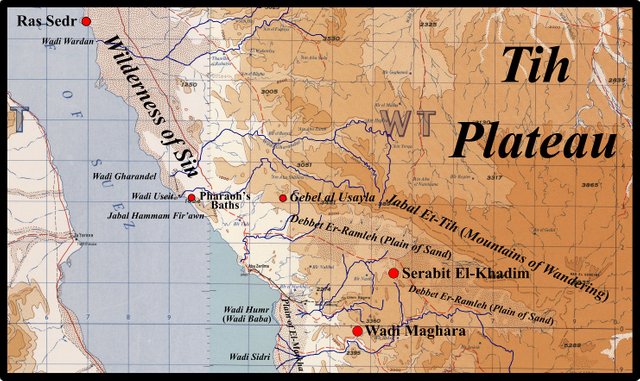
We have been working on the assumption that the Mountain of God, where Moses receives the Tablets of the Law, was at Serabit el-Khadim—a hypothesis first proposed by Lina Eckenstein a century ago. We have also been assuming that the Israelites were capable of covering around 20-30 km per day over favourable terrain (Hoffmeier 120). As it happens, Gebel al-Usayla lies about 29 km from Serabit el-Khadim as the crow flies, so this hypothetical itinerary is not impossible. The Mountain of God is in the Wilderness of Sinai, which is the next station after Rephidim. If we are on the right track, Rephidim should be sought somewhere in the Debbet er-Ramleh—precisely the sort of terrain in which water would have been scarce.
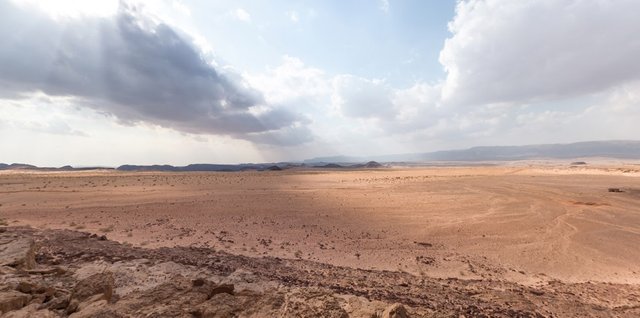
It is possible, however, that Rephidim was relatively close to the Mountain of God. In Exodus 17:4-6, when Moses appeals to God for water, we read:
And Moses cried unto the Lord, saying, What shall I do unto this people? they be almost ready to stone me. And the Lord said unto Moses, Go on before the people, and take with thee of the elders of Israel; and thy rod, wherewith thou smotest the river, take in thine hand, and go. Behold, I will stand before thee there upon the rock in Horeb; and thou shalt smite the rock, and there shall come water out of it, that the people may drink. And Moses did so in the sight of the elders of Israel. (Exodus 17:4-6)
In The Jewish Study Bible, Jeffrey H. Tigay comments:
Rephidim, the last station before Sinai (19.2; Num. 33-14-15) and, to judge from v. 6, near [Mount] Sinai ... Moses is to take some of the elders, perhaps as witnesses, and set out for Horeb (Sinai), “the mountain of God” (3.1), to obtain water. Apparently the water would flow from Horeb back to Rephidim via a wadi (cf. 32:20; Deut. 9:21). (Berlin & Brettler142)
In Deuteronomy 9:21, Moses says of the Golden Calf:
And I took your sin, the calf which ye had made, and burnt it with fire, and stamped it, and ground it very small, even until it was as small as dust: and I cast the dust thereof into the brook that descended out of the mount. (Deuteronomy 9:21)
The implication is that Rephidim lies “downstream” from the Mountain of God: Moses and some of the elders walk from Rephidim to the Mountain : Moses strikes a rock on the Mountain : Water flows from this rock down to Rephidim for the Israelites to drink.
Other details have even led some scholars to wonder whether Rephidim and the Mountain of God were one and the same:
A number of commentators have noted that events at Rephidim appear to be “confused” with events at Mount Sinai, could the nearness of these two sites to each other be the source of the confusion (identifying Rephidim with “the mountain of God”)? After Moses’ victory over the Amalekites, his father-in-law Jethro arrives to the mountain of God (Hebrew Har El), and blesses Israel’s God who has achieved victory over the foe (Ex 18:1,5). The water at Rephidim comes from a rock called Horeb/Choreb (Ex 17:6). (Walter Mattfeld)
In an earlier article, we noted that two of the mountain peaks in the vicinity of Serabit el-Khadim have the names Gebel Ghorabi and Gebel Saniya, which could be the origin of the names Horeb and Sinai for the Mountain of God:
Mountain of God] Sometimes named Horeb, at other times Sinai. The mountain itself had two peaks; one was called Horeb, the other Sinai. Horeb was probably the primitive name of the mountain, which was afterward called the mountain of God, because God appeared upon it to Moses; and Mount Sinai, סיני, from סנה seneh, a bush, because it was in a bush or bramble, in a flame of fire, that this appearance [ie the burning bush] was made. (Clarke 301)
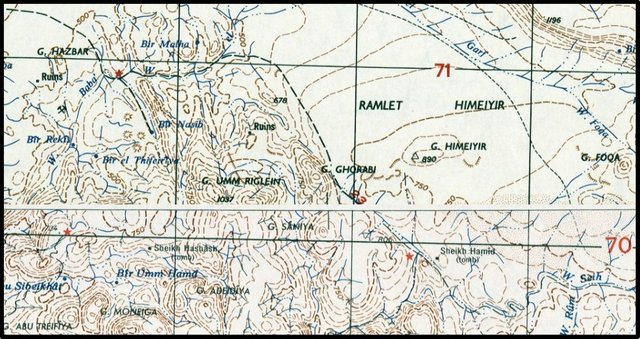
Etymology of Rephidim
Rephidim is Number 7508 in Strong’s Exhaustive Concordance of the Bible_. Strong takes it to be the masculine plural of Number 7507: Rephidah, a railing, which in turn he derives from the primitive root Number 7502: raphad, to spread, to refresh.
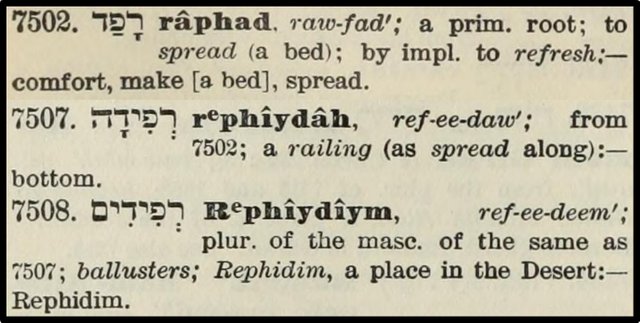
Curiously, James Hoffmeier assigns a different meaning to Strong’s primitive root:
The word Rephidim (רְפִידׅים) appears to derive from the root rpd [רפד], which means help, support, aid, and which, it has been suggested, reflects the divine assistance required to defeat the Amalekites. Although this is an intriguing suggestion, it is not without its problems. If an etiology stands behind the name, no explanation for it is offered in the text. Hoffmeier 170)
This is supported by A Hebrew and English Lexicon of the Old Testament:
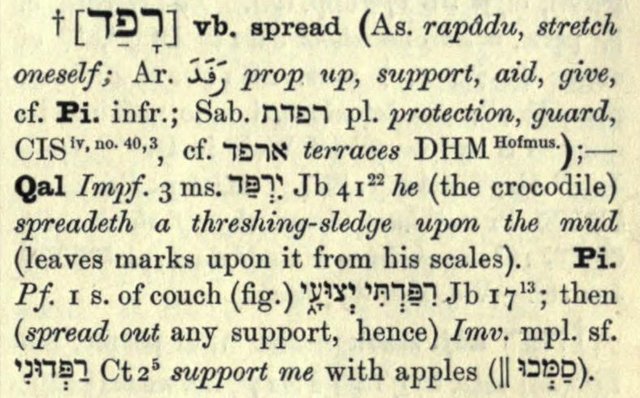
On the same page of his Ancient Israel in Sinai, Hoffmeier makes another significant point:
In the episode contained within this chapter, the people complained and tested God (Exod. 17:3–7). Exodus 17:7 concludes, “He called the place Massah and Meribah, because the Israelites quarreled and tested the Lord” ... This statement suggests that Rephidim was already the name of the site when the Israelites arrived, but owing to the story of Israel’s actions, Massah and Meribah were attached to the site. (Hoffmeier 170)
If this is true, the etymology of Rephidim is unlikely to be Hebrew—and if Hebrew is ruled out, Arabic and Ancient Egyptian are the obvious alternatives. However, I have been unable to find any speculations—scholarly or otherwise—on possible Arabic or Egyptian etymologies of this toponym. Browsing through Pierret’s Vocabulaire Hiéroglyphique and Budge’s An Egyptian Hieroglyphic Dictionary, I failed to turn up anything promising. Perhaps the traditional Hebrew etymology (rests, stays, supports, props) is correct after all.
Feiran Oasis
One of the most popular candidates for Rephidim—one might call it the traditional site—is the Oasis of Wadi Feiran:
At the base of [Mount] Serbal, in Wady Feiran, is a large and comparatively fertile tract, with a palm-grove which extends, notwithstanding the late destructive flood, for miles along the valley. It is, in fact, the most fertile part of the Peninsula, and one which the Amalekites would be naturally anxious to defend against an invading force ; in this respect therefore it answers to the position of Rephidim. (Palmer 158)
The principal objection to this identification is that both Biblical accounts of Rephidim (Exodus and Numbers) specifically mention the lack of water, which is the last thing one would expect to encounter at a fertile oasis. Nevertheless, commentators who favour this location suggest that the Israelites expected to find water here but were disappointed (Orr 2560).
In the preceding article of this series, we learnt that some scholars identified this site with the previous station, Alush, named allegedly after El-Hesueh, a spring which joins the Wadi Feiran at this point.
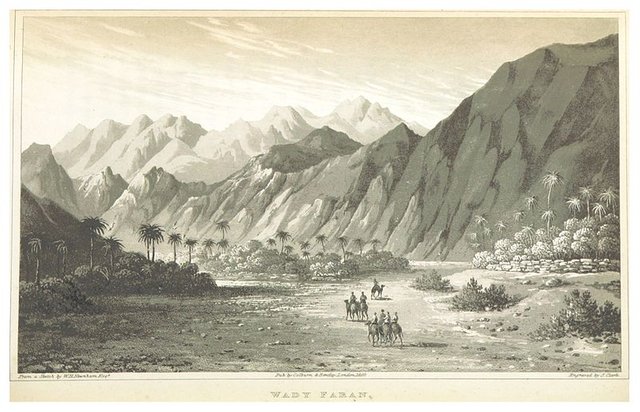
Wadi Refayid
Another candidate that one comes across is an elusive wadi in the same general region:
The name Rephidim has also been connected by some modern scholars with another valley in the area called Wadi Refayid. Simons agreed with this identification, and pointed out that within the wadi is an oasis and mountain called Refayid. In this case, the Arabic name appears to preserve Rephidim remarkably well. Graham Davies considered the equation between these two names to be a plausible example of the Arabic name preserving an earlier Semitic toponym. (Hoffmeier 170)
The problem with correspondences like this is that one can never be sure whether the local name preceded the Exodus or was applied at a later date, when the place in question, rightly or wrongly, had come to be identified with a particular Station of the Exodus. In this case, however, it appears that Wadi Refayid is a misreading of Wadi Rufayil, as independent researcher Walter Mattfeld has discovered:
Despite repeated attempts over the past 10 years I had no success in finding a “Wadi Refayid” on my set of Sinai maps (map scale 1:100,000 made in the 1930’s). However, today (10 October 2005) I made a Google Internet search for the “mysterious Wadi Refayid” claimed to possibly be Rephidim by earlier scholars (pre 1980’s) and can report “success” at long last! Apparently Wadi Refayid is Wadi Rufayil on my map (Feiran. Sheet 8. Scale: 1:100,000. Survey of Egypt. London. 1937). Is it possible some scholars in error read the last letter L as D? (Investigating the Pre-Biblical Origins of the Holy Bible via Archaeology)
In my opinion, the similarity between Rephidim and Rufayil is too slender to support such a weighty hypothesis.

Water from the Rock
It was during the Israelites’ sojourn at Rephidim that Moses first produced water from a rock by striking it with his staff, as we have seen above. This account in the Book of Exodus is curiously preminiscent—to coin a phrase—of a similar incident recounted in Numbers:
Then came the children of Israel, even the whole congregation, into the desert of Zin in the first month: and the people abode in Kadesh ... And there was no water for the congregation: and they gathered themselves together against Moses and against Aaron. And the people chode with Moses, and spake, saying, Would God that we had died when our brethren died before the Lord! And why have ye brought up the congregation of the Lord into this wilderness, that we and our cattle should die there? And wherefore have ye made us to come up out of Egypt, to bring us in unto this evil place? it is no place of seed, or of figs, or of vines, or of pomegranates; neither is there any water to drink. And Moses and Aaron went from the presence of the assembly unto the door of the tabernacle of the congregation, and they fell upon their faces: and the glory of the Lord appeared unto them. And the Lord spake unto Moses, saying, Take the rod, and gather thou the assembly together, thou, and Aaron thy brother, and speak ye unto the rock before their eyes; and it shall give forth his water, and thou shalt bring forth to them water out of the rock: so thou shalt give the congregation and their beasts drink. And Moses took the rod from before the Lord, as he commanded him. And Moses and Aaron gathered the congregation together before the rock, and he said unto them, Hear now, ye rebels; must we fetch you water out of this rock? And Moses lifted up his hand, and with his rod he smote the rock twice: and the water came out abundantly, and the congregation drank, and their beasts also. And the Lord spake unto Moses and Aaron, Because ye believed me not, to sanctify me in the eyes of the children of Israel, therefore ye shall not bring this congregation into the land which I have given them. This is the water of Meribah; because the children of Israel strove with the Lord, and he was sanctified in them. (Numbers 20:01-13)
It is natural to see in these two accounts the gemination of a single event. But which is the historical event and which the doublet? Is this miracle based upon something that occurred at Rephidim or at Kadesh Barnea?
As we have seen, both accounts of the sojourn at Rephidim specifically mention the lack of water at this station. This provides the pretext for Moses’ miracle, which in turn suggests that any historical event behind this miracle must have occurred at Rephidim. Therefore, the account in Numbers is the spurious one.
If, on the other hand, the account in Exodus is the spurious one, a rabbinical scholar, looking for a suitable place in which to insert this story, may well have added it to the account of the sojourn at Rephidim precisely because of the lack of water at that station. Therefore, the account in Numbers is the genuine one.
Let us accept for the moment that the event in question took place at Rephidim. What does this tell us about the location of this station? We have already answered this question: Rephidim lay downstream from the Mountain of God—in, or at the mouth of, a wadi. As a glance at a topographic map of the environs of Serabit el-Khadim will reveal, there’s a multitude of sinuous wadis in this area, flowing down from the uplands in all directions. Wadi Suwiq, which is fed by several tributaries in the neighbourhood of Serabit el-Khadim, is particularly prominent.
But the historicity of the story is too doubtful to use such reasoning to pinpoint the location of Rephidim. Following the itinerary I am proposing in these articles, Rephidim probably lay somewhere in the Debbet er-Ramleh close to Serabit el-Khadim.
You may remember that the Israelites also complained about a lack of drinking water at Marah, the fifth Station of the Exodus (Exodus 15:22-27). On that occasion, Moses sweetened the waters by casting a tree into it. It is possible, then, that a single event has been triplicated (Buttrick et al 957), but this does not leave us any closer to pinning down the location of Rephidim.
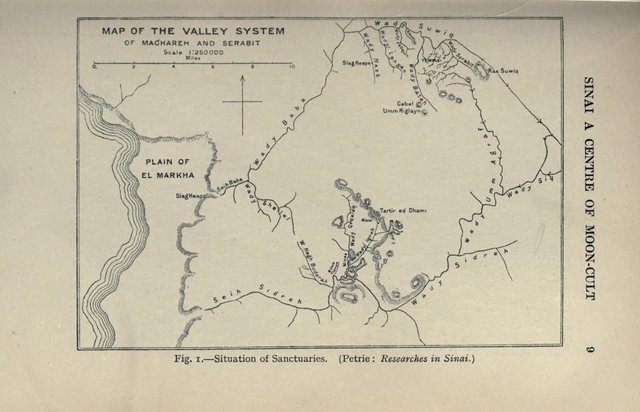
Amalekites
Another important event is alleged to have occurred during the sojourn at Rephidim: the Battle of Rephidim, in which the Israelites defeated the Amalekites. Who were the Amalekites and why did they attack the Israelites? These are questions we will attempt to answer in the following article.
To be continued ...
References
- Adele Berlin & Marc Zvi Brettler (editors), _The Jewish Study Bible , Jewish Publication Society TANAKH Translation, Oxford University Press, Oxford (1999)
- Francis Brown, Edward Robinson, William Gesenius, A Hebrew and English Lexicon of the Old Testament, Clarendon Press, Oxford (1906)
- E A Wallis Budge, An Egyptian Hieroglyphic Dictionary, Volume 1, John Murray, London (1920)
- George Arthur Buttrick et al, The Interpreter’s Bible, Volume 1, Abingdon Press, Nashville TN (1984)
- Adam Clarke, The Holy Bible ... With a Commentary and Critical Notes, Volume 1, G Lane & C B Tippett, New York (1846)
- Lina Eckenstein, A History of Sinai, Society for Promoting Christian Knowledge, London (1921)
- James K Hoffmeier, Ancient Israel in Sinai: The Evidence for the Authenticity of the Wilderness Tradition, Oxford University Press, Oxford (2005)
- James Orr (General Editor), The International Standard Bible Encyclopedia, Volume 4, The Howard-Severance Company, Chicago (1915)
- Edward Henry Palmer, Desert of the Exodus: Journeys on Foot in the Wilderness of the Forty Years’ Wanderings, Deighton, Bell, and Co, Cambridge (1871)
- Paul Pierret, Vocabulaire Hiéroglyphique, F Vieweg, Paris (1875)
- Samuel Prideaux Tregelles, Wilhelm Gesenius, A Hebrew and Chaldee Lexicon to the Old Testament Scriptures, Bagster, London (1857)
- James Strong, Hebrew and Chaldee Dictionary, in The Exhaustive Concordance of the Bible, Eaton & Mains, New York (1890)
Image Credits
- Looking South-East Across the Debbet Er-Ramleh: © 2014 Salma El Dardiry, Fair Use
- The Western Sinai Peninsula: University of Texas Libraries, Perry-Castañeda Library Map Collection, Aqaba, Suez, D Survey, Great Britain War Office and Air Ministry (1960), Public Domain
- Serabit el-Khadim and Environs: University of Texas Libraries, Perry-Castañeda Library Map Collection, NH 36-11 Qal’at El Nakhl, NH 36-15 Tor, Army Map Service (AMPV), Corps of Engineers, U. S. Army, Washington DC, Public Domain
- The Oasis of Wadi Feiran: James Webster, Travels through the Crimea, Turkey and Egypt, Volume 2, p 210, British Library HMNTS 1046.k.23, Public Domain
- Moses Striking Water from the Rock (Tintoretto): Tintoretto (artist), Städel Museum, Public Domain

Your post has been curated by the bitcoin myk project. Tokens are available for this account you can trade for steem at: https://steem-engine.com/. Join our curation priority list to earn more tokens by registering at:
http://www.bitcoinmyk.com/register/
Visit our discord at: https://discordapp.com/channels/523971711733858364/523971711733858366
Bitcoin MYK
admin
Register - Bitcoin MYK
This post earned 250 BTCMYK
Downvoting a post can decrease pending rewards and make it less visible. Common reasons:
Submit
hi dear @harlotscurse, your post is very interesting, so rich in history and details! are you so prepared on these topics, have you studied history or is it your passion ?? congratulations on your work and on the curie vote
Downvoting a post can decrease pending rewards and make it less visible. Common reasons:
Submit
Thank you. History is just one of my many passions.
Downvoting a post can decrease pending rewards and make it less visible. Common reasons:
Submit
Great post. I don't want to rate this post because it would be from me bold. However, this review seems to me and the arguments of the same are very valid. Photographs, maps and textual quotes are very well chosen. A cordial greeting @harlotscurse
Downvoting a post can decrease pending rewards and make it less visible. Common reasons:
Submit
Thank you.
Downvoting a post can decrease pending rewards and make it less visible. Common reasons:
Submit
Hi harlotscurse,
Visit curiesteem.com or join the Curie Discord community to learn more.
Downvoting a post can decrease pending rewards and make it less visible. Common reasons:
Submit